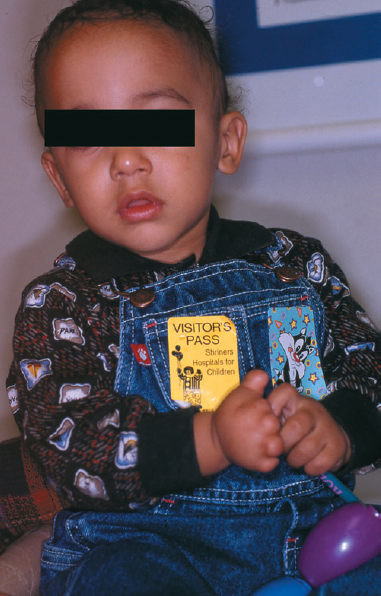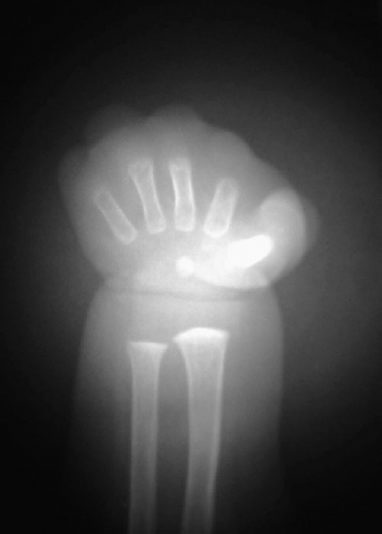75
Transverse Deficiency of the Digits
Scott H. Kozin
History and Clinical Presentation
A 10-month-old boy presented with a congenital anomaly of the right hand (Fig. 75–1). He is the product of a full-term normal vaginal delivery. There were no complications during pregnancy or delivery. The child uses the right hand for bimanual activity and is otherwise healthy. Developmental milestones have been reached at the appropriate time. He is an only child, and there is no family history of congenital anomalies.
PEARLS
- Transverse deficiencies of the digits are most common at the phalangeal level.
- Deficient hands with intact metacarpophalangeal joints and small proximal phalanges are very adept at function.
- Nonvascularized toe phalangeal transfer requires extra-periosteal dissection.
PITFALLS
- Nonvascularized toe phalangeal transfer does not result in prolonged growth.
- Distraction osteogenesis requires frequent monitoring to avoid potential complications.
- Toe-to-hand transfer is difficult in adactyly and may require multiple toe transfers.
Physical Examination
A healthy-appearing infant with an isolated anomaly of the right upper extremity. The right shoulder, elbow, forearm, and wrist appear normal and equal in size when compared with the left side. The right hand is abnormal with absence of the thumb, index, long, ring, and small digits (Fig. 75–2). There are palpable metacarpals, but no phalanges appreciated. There is excellent skin coverage and skin tubes are present where the phalanges would be expected. No amniotic bands or chest wall abnormalities were noted.

Figure 75–1 A 10-monthold with congenital anomaly of the right hand.

Figure 75–2 Anomalous right hand with absent thumb, index, long, ring, and small digits.
Diagnostic Imaging
Radiograph of the right hand demonstrated five metacarpals with absent phalanges (Fig. 75–3). A comparison radiograph of the left hand revealed five metacarpals and normal phalanges.

Figure 75–3 Radiograph of right hand with normal metacarpals and absent phalanges.
Differential Diagnosis
Brachydactyly
Poland syndrome
Transverse deficiency of the digits
Constriction band syndrome
Brachydactyly refers to a short hypoplastic digit that has the normal complement of bones. The index and small fingers are most commonly affected. The shortening most commonly involves the middle phalanx, which is the last phalanx to ossify. Poland syndrome combines hand hypoplasia with chest wall abnormalities and is usually sporadic in occurrence. The most common hand anomaly is symbrachydactyly (syndactyly combined with brachydactyly), and the typical chest abnormality is ipsilateral absence of the sternocostal portion of the pectoralis major muscle. Constriction band syndrome is a result of entrapment of developing embryonal tissue by fetal lining. Mild band formation can cause simple constriction rings that are primarily a cosmetic deformity, whereas severe bands can cause autoamputation of the digits. As in transverse deficiency of the digits, the thumb is often spared. The diagnosis of constriction band requires the presence of a constriction band either in the hand or elsewhere.
Diagnosis
Transverse Deficiency of the Digits
Stay updated, free articles. Join our Telegram channel

Full access? Get Clinical Tree








